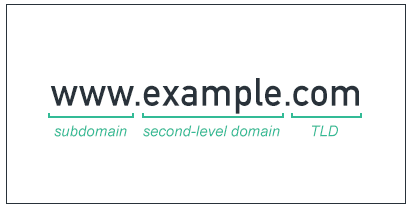Physical Address
304 North Cardinal St.
Dorchester Center, MA 02124
Physical Address
304 North Cardinal St.
Dorchester Center, MA 02124

Picking the right top-level domain (TLD) for your business website goes beyond technicality—it’s a strategic decision that can greatly influence your brand’s online presence and credibility.
Modern TLD choices now range from industry-specific options like .tech, .health, or .finance to more playful choices like .guru, .ninja, or .cool. These new TLDs offer a chance to make your website more unique, relevant, and reflective of your brand.
In this guide, we’ll explore the different TLD options and offer practical tips on finding the best fit for your business. Whether you’re launching a website or rebranding, choosing the right TLD is essential.
Domains follow a hierarchical structure, with the top-level domain (TLD) at the top, often referred to as the “domain extension.”
The .com TLD is the most recognizable, frequently viewed as the standard. Studies like Joseph B. Walther’s 2004 research, The Effect of Top-Level Domains and Advertisements on Health Web Site Credibility, show that TLDs can shape perceptions of credibility and trustworthiness.
Today, with social media and bookmarking, the need for domain memorability has decreased, and the rapid growth of the internet has pushed site owners toward alternative TLDs.

The Internet Corporation for Assigned Names and Numbers (ICANN) and the Internet Assigned Numbers Authority (IANA) currently oversee over 1,500 TLDs. While some have specific requirements, more than 1,200 are general top-level domains (gTLDs) open to all.
Traditional domains like .com, .net, and .org remain popular but often come at a premium. Meanwhile, newer options like .io (popular in tech) and location-based TLDs like .nyc (ideal for local businesses) are growing in popularity.
Some well-known gTLDs include:
Country-specific TLDs (e.g., .jp for Japan) are often intended for use within that country but can also be creatively repurposed. For instance, Italy’s .it is popular among IT businesses.
Availability depends on local regulations, so check with your domain registrar. Be aware that a country-specific TLD may lead users to assume a local presence.
Choosing the right TLD offers an opportunity to enhance your brand’s identity through a distinctive web address.
Be thorough and consider all angles—think about both human and algorithmic interpretations of your domain.
Once you’ve found the right TLD, register it through a domain registrar or a web host that offers this service, such as Bluehost or GoDaddy. For additional support, check out our recommendations for top domain registrars and hosting providers.